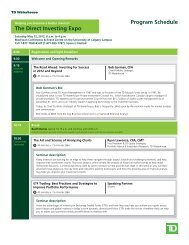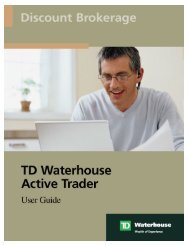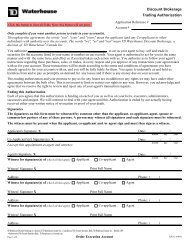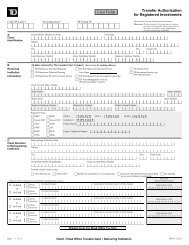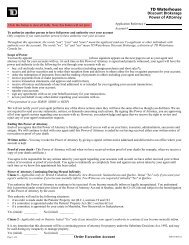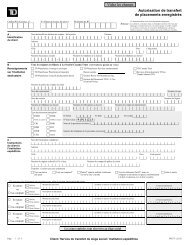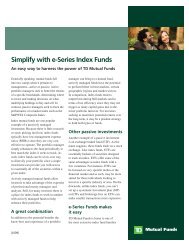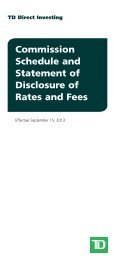New Markets & Research Portal WebBroker ... - TD Waterhouse
New Markets & Research Portal WebBroker ... - TD Waterhouse
New Markets & Research Portal WebBroker ... - TD Waterhouse
You also want an ePaper? Increase the reach of your titles
YUMPU automatically turns print PDFs into web optimized ePapers that Google loves.
<strong>New</strong> <strong>Markets</strong> &<br />
<strong>Research</strong> <strong>Portal</strong><br />
<strong>WebBroker</strong> *<br />
–<br />
Enhanced<br />
Performance<br />
Is the Stock<br />
Market an Efficient,<br />
Rational Pricing<br />
Mechanism?<br />
www.tdwaterhouse.ca<br />
<strong>TD</strong> WATERHOUSE INVESTOR SERVICES<br />
NEWS<br />
S E P T E M B E R 2 0 0 1
2<br />
Exclusive <strong>New</strong> “<strong>Markets</strong> & <strong>Research</strong>” Site Is Here!<br />
Most comprehensive site of its kind in Canada – Available Free to Clients<br />
<strong>TD</strong> <strong>Waterhouse</strong> has launched the most<br />
comprehensive markets and research<br />
website of its kind in Canada, with all<br />
research available free to clients.<br />
“We are thrilled to offer our clients access<br />
to a caliber of research and market<br />
information, that – until now – was<br />
unavailable to the self-directed investor in<br />
Canada,” says John See, Vice-Chairman,<br />
<strong>TD</strong> <strong>Waterhouse</strong> Group, Inc. “This is a key<br />
part of our strategy – to deliver the best<br />
value proposition, and empower our clients<br />
with the tools they need to make their<br />
investment decisions.”<br />
To access the new <strong>Markets</strong> & <strong>Research</strong> site<br />
or portal, <strong>TD</strong> <strong>Waterhouse</strong> clients simply<br />
log on to the new version of <strong>WebBroker</strong>*–<br />
our premiere Internet-based brokerage<br />
service. (For more about the new version<br />
of <strong>WebBroker</strong>, see “Focus on <strong>Research</strong>,”<br />
page 4.)<br />
Once online, clients can use the tools and<br />
information on the site to research<br />
thousands of Canadian and U.S. securities,<br />
as well as industry sectors and economic<br />
trends. A version of the site can be<br />
sampled via our public website at<br />
www.tdwaterhouse.ca/markets<br />
Exclusive research for <strong>TD</strong> <strong>Waterhouse</strong><br />
clients<br />
“When we developed the <strong>Markets</strong> &<br />
<strong>Research</strong> portal, we wanted to give our<br />
clients something no one else was<br />
offering,” explains David Sypher, Senior<br />
Vice President, Direct Channels,<br />
<strong>TD</strong> <strong>Waterhouse</strong>. “With the type of<br />
information and exclusive research we’re<br />
placing at their fingertips, we think we’re<br />
providing our clients with a significant<br />
investment advantage.”<br />
In developing the new site, <strong>TD</strong> <strong>Waterhouse</strong><br />
built an offering of reports and information<br />
typically only available to institutional<br />
brokerage customers. <strong>TD</strong> <strong>Waterhouse</strong><br />
clients now have exclusive access to:<br />
• Proprietary research from<br />
<strong>TD</strong> <strong>New</strong>crest* & <strong>TD</strong> Securities*<br />
<strong>TD</strong> Securities <strong>Research</strong> is highly<br />
regarded in the securities industry for its<br />
sector knowledge, commission impact<br />
and report quality.<br />
• Access proprietary comparative analysis,<br />
key company and industry financials, and<br />
buy/reduce/hold recommendations –<br />
formerly only available to fullcommission<br />
brokers.<br />
• Select customized, institutional quality<br />
industry and company reports spanning<br />
18 sectors.<br />
• Each morning you will receive a report<br />
providing company updates and new<br />
recommendations to stay on top of daily<br />
developments.<br />
• Standard & Poor’s “The Outlook” –<br />
a regular weekly report on the latest<br />
market commentary and recommended<br />
stocks from S&P’s analysts.<br />
The most comprehensive tools &<br />
information, at no cost<br />
In addition to the exclusive research<br />
already mentioned, the new <strong>Markets</strong> &<br />
<strong>Research</strong> site is designed to provide clients<br />
with a broad selection of investment tools<br />
and information, all free of charge. This<br />
includes:<br />
• Fundamental data on various securities<br />
from the Financial Post and MarketGuide<br />
• Live news feeds from Bridge, Canada<br />
<strong>New</strong>swire and CBS MarketWatch<br />
• Market commentaries from Argus,<br />
Bridge, <strong>TD</strong> Asset Management,<br />
<strong>TD</strong> Economics, and Briefing.com<br />
• Analyst reports from First Call, Vickers,<br />
and Standard & Poor’s<br />
• Earnings reports and notifications from<br />
First Call and CCBN<br />
• Stock screening using data provided by<br />
MarketGuide, the Financial Post and<br />
Standard & Poor’s that helps you find<br />
growth, value, high-yield stocks, and more.<br />
• Mutual fund tools from Morningstar<br />
including the Analysts’ Choice* Funds<br />
(see below)<br />
In addition to our new research portal,<br />
clients also have access to our Fixed<br />
Income Centre and the Morningstar<br />
Canada <strong>Research</strong> Website.<br />
<strong>Research</strong> & trade bonds via our Fixed<br />
Income Centre<br />
Whether you’re a seasoned bond trader or<br />
an investor seeking to diversify your<br />
portfolio, <strong>TD</strong> <strong>Waterhouse</strong> puts online fixed<br />
income trading and information at your<br />
fingertips. Available free to all <strong>WebBroker</strong><br />
clients, the <strong>TD</strong> <strong>Waterhouse</strong> Fixed Income<br />
Centre allows you to:<br />
• Buy and sell bonds and money market<br />
securities online<br />
• Search for a bond that meets your<br />
specific investment criteria<br />
• Find prices and yields on numerous<br />
bonds and money market instruments<br />
• View daily commentary on the fixed<br />
income market<br />
• Review credit ratings from Dominion<br />
Bond Rating Service (DBRS), Standard<br />
and Poor’s (S&P) and Moody’s<br />
Types of bonds available through the Fixed<br />
Income Centre:<br />
• Government of Canada bonds<br />
• Government agency bonds<br />
• Provincial bonds<br />
• Municipal bonds<br />
• Investment Grade Corporate bonds<br />
• Zero Coupon or Strip Bonds (from a<br />
variety of issuers – i.e. federal, provincial<br />
government)<br />
Types of money market investments<br />
available – in terms of 30, 60, 90, 180 days<br />
and one year:<br />
• Government of Canada Treasury Bills<br />
• Bankers’ Acceptances & Bearer Deposit<br />
Notes<br />
• Commercial Paper rated R-1 by DBRS<br />
(R-1 is “Prime Credit Quality”)<br />
Other highlights of the Fixed Income<br />
Centre include:<br />
• Quick Picks – Allows you to search for a<br />
bond or money market security quickly,<br />
based on the term to maturity.<br />
• Fixed Income Lookup – Search the<br />
entire list of bond offerings available, by<br />
security type, issuer, frequency, maturity,<br />
coupon, etc.<br />
• Build Your Own Bond Ladder – Assists<br />
you in building a ‘ladder’ of bonds with<br />
different maturities that may reduce your<br />
portfolio’s sensitivity to interest rate<br />
fluctuations.<br />
• Market Commentary – A weekly update<br />
from <strong>TD</strong> Securities highlighting the<br />
factors that influence the bond market.<br />
Morningstar Canada <strong>Research</strong> Website<br />
Through our alliance with Morningstar<br />
Canada, <strong>TD</strong> <strong>Waterhouse</strong> clients have free
online access to one of the most<br />
comprehensive and unbiased sources of<br />
market information, investments and<br />
research tools in the industry. Highlights<br />
include:<br />
• Fund Focus – Short list of recent articles<br />
about funds to watch<br />
• Fund Selector – Enhanced search engine<br />
that allows you to select a mutual fund<br />
based on your specific search criteria<br />
• Fund Quicktakes – Four-page, detailed<br />
report on an individual fund’s price,<br />
performance, portfolio holdings,<br />
management and fees. You can quickly<br />
check a fund’s Morningstar Rating,<br />
review its asset and geographic content,<br />
and view its top -10 holdings.<br />
• Fund Indices – List of mutual fund<br />
indices and returns, organized by<br />
Investment Funds Standards Committee<br />
categories<br />
• Analysts’ Choice* Funds – Exclusive<br />
to <strong>TD</strong> <strong>Waterhouse</strong> clients, <strong>TD</strong> Asset<br />
Management Inc.* provides a list of<br />
high-quality funds, in each major<br />
investment category, that stand out from<br />
their peers in terms of above-average<br />
historical performance and consistency<br />
of returns.<br />
• My Watch List – Allows you to track<br />
changes to your list of funds and see<br />
their performance relative to Morningstar<br />
indices.<br />
• Stock Focus – Similar to Fund Focus<br />
• Stock Quicktakes – Similar to Fund<br />
Quicktake Reports<br />
• US Analysts’ Reports – Links to recent<br />
reports about stocks on the move<br />
• Tech Bytes – Links to timely articles on<br />
the tech sector and specific stocks to<br />
consider<br />
• Editorial Content – Includes feature<br />
articles, commentaries, analysis and<br />
reports<br />
Morningstar Canada is an invaluable<br />
resource for all self-directed investors.<br />
Information on the site is always changing,<br />
so visit it often.<br />
Visit our new <strong>Markets</strong> & <strong>Research</strong> site<br />
today, and learn how it can help you<br />
become the best investor you can be.<br />
bondcorner<br />
Inside Asset Backed Securities<br />
Brought to you by <strong>TD</strong> Securities. By Adam R. Parkin, Trader<br />
Fixed income investors are often faced<br />
with a tradeoff between credit quality and<br />
yield. In an environment with rising credit<br />
defaults and an uncertain economic<br />
outlook, credit quality is important, but<br />
investing in bonds of higher quality often<br />
results in a sacrifice of yield. Asset Backed<br />
Securities, more commonly referred to as<br />
ABS, may offer a credit conscious Fixed<br />
Income Investor with the safety and<br />
security of highly rated bonds, while<br />
providing an increased yield over similarly<br />
rated securities.<br />
What are Asset Backed Securities?<br />
Asset Backed Securities are bonds backed<br />
by a select, diversified and defined pool of<br />
assets. These assets can be pools of<br />
financial receivables such as credit cards,<br />
auto leases, personal lines of credit or<br />
commercial mortgages. The assets are held<br />
in trust by a “special purpose vehicle”<br />
(typically a trust) and are structured with<br />
various credit enhancements to receive the<br />
highest possible credit rating –“AAA”.<br />
The structuring and credit enhancement of<br />
the assets helps to provide corporations,<br />
such as banks, with a cost-effective means<br />
of raising capital while providing investors<br />
with a stable and secure fixed income<br />
investment.<br />
Asset Backed Securities were first<br />
introduced into the Canadian bond market<br />
in 1987 and have since grown to over $20<br />
Billion in total bonds outstanding. The<br />
safety and security of Asset Backed<br />
Securities in Canada has been<br />
demonstrated by the asset class’s track<br />
record of zero defaults since its inception.<br />
The positive characteristics of Asset<br />
Backed Securities have made it a popular<br />
investment among large institutional<br />
investors such as insurance companies and<br />
pension funds, and it is forecast that the<br />
strong growth and acceptance of these<br />
bonds will continue.<br />
Benefits of Asset Backed Securities<br />
• Attractive yields compared to similar<br />
rated bonds<br />
• Secure credit rating – usually “AAA”<br />
• Actively traded, liquid market<br />
• Spreads have remained stable during<br />
periods of market volatility<br />
• Bond collateral is actively managed and<br />
monitored<br />
• Bonds rated by two or more ratings<br />
companies<br />
• Less sensitive to dramatic market events<br />
Why Invest in Asset Backed Securities?<br />
Asset Backed Securities can provide<br />
investors with a higher yield alternative to<br />
GICs, Government of Canada and<br />
Provincial Bonds. Maturities typically<br />
range from one to ten years and payment<br />
frequencies, although traditionally semiannual,<br />
also include monthly pay and<br />
amortizing monthly paying bonds. The<br />
security of ABS makes these bonds<br />
attractive to all types of investors; however,<br />
most ABSs do not qualify for investments<br />
in RRSP, RRIF or RESP accounts.<br />
Types of Asset Backed Securities<br />
Below is a list of the ABSs available to<br />
<strong>TD</strong> <strong>Waterhouse</strong> clients. Each trust has a<br />
multiple series of bonds with different<br />
maturities.<br />
• Genesis Trust – Personal Lines of Credit<br />
Secured by home equity generated by<br />
Canada Trust PowerLine Accounts<br />
• Gloucester Credit Card Trust –<br />
MasterCard credit card receivables<br />
originated by MBNA Bank of Canada<br />
• Golden Credit Card Trust – VISA credit<br />
card receivables originated by the Royal<br />
Bank of Canada<br />
• Hollis Receivables Trust – Personal lines<br />
of credit generated by ScotiaLine<br />
Accounts<br />
• Solar Trust – commercial mortgages<br />
originated by Commercial Mortgage<br />
Origination Company of Canada<br />
The minimum required purchase of<br />
Asset Backed Securities is $5,000 face<br />
value and quantities above $5,000 are<br />
purchased in increments of $1,000 face<br />
value. For further information, pricing and<br />
product availability please contact your<br />
<strong>TD</strong> <strong>Waterhouse</strong> Fixed Income Representative<br />
at 1-888-983-2663 or 1-888-983-BOND.<br />
3
4<br />
F O C U S O N R E S E A R C H<br />
Exciting <strong>New</strong> Version of <strong>WebBroker</strong> is being Launched!<br />
A new version of <strong>WebBroker</strong>* offers you<br />
a faster log-in process, plus streamlined,<br />
intuitive navigation that helps you access<br />
the market research you need to make<br />
informed investment decisions, and place<br />
your trade orders quickly and easily.<br />
Whether you’re just thinking about<br />
web-based trading, or have been trading<br />
online for years — check-out these<br />
exciting, user-friendly features available<br />
now through <strong>WebBroker</strong> — Canada’s<br />
premiere Internet-based brokerage<br />
service, exclusively from<br />
<strong>TD</strong> <strong>Waterhouse</strong> — www.tdwaterhouse.ca<br />
Faster access to tools & research<br />
• <strong>Markets</strong> & <strong>Research</strong> – The unparalleled<br />
selection of online market information<br />
and research tools from <strong>TD</strong> <strong>Waterhouse</strong><br />
is now even better and it’s FREE to all<br />
clients via <strong>WebBroker</strong>! Access a wide<br />
range of <strong>TD</strong>-proprietary research, and<br />
Canada’s most extensive range of thirdparty<br />
investment research. (For more<br />
information, see the “<strong>Markets</strong> &<br />
<strong>Research</strong>” article on page 2.)<br />
• Portfolio Tracker – With the enhanced<br />
Portfolio Tracker, you can retrieve<br />
summary and detail quotes on your<br />
existing model portfolios.<br />
• Quick Quote – Retrieve multiple realtime<br />
quotes in any combination of<br />
equities, options, mutual funds and<br />
indices.<br />
• Favourite Websites – Create and save<br />
up to five links to your favourite<br />
websites, and visit them while<br />
navigating within <strong>WebBroker</strong>.<br />
• Option Symbol Lookup – The strike<br />
prices for most puts and calls offered<br />
through <strong>TD</strong> <strong>Waterhouse</strong> are now<br />
displayed.<br />
• Fixed Income Centre – <strong>WebBroker</strong><br />
clients can now log on and use this<br />
valuable resource to find prices, yields<br />
and credit ratings on more than 1,000<br />
bonds and money market securities,<br />
and place orders online.<br />
• Market Tracker – Click on this<br />
<strong>WebBroker</strong> link to see our Market<br />
Summary page with Canadian, U.S.<br />
and international market indices.<br />
Faster Trading<br />
• Efficient & Intuitive Navigation – A<br />
quicker log-on process allows for faster<br />
access to your account, trading and<br />
research tools.<br />
• Portfolio Tracker transactions – You<br />
can now place buy and sell orders<br />
directly from your portfolio(s) in<br />
Portfolio Tracker. Create and track<br />
information on up to five model<br />
portfolios in real time.<br />
• Enhanced Mutual Fund Transactions<br />
– Switch investments from one fund to<br />
another (within the same fund family),<br />
and review mutual fund orders, in<br />
detail, using the ‘List Orders’ feature.<br />
• <strong>New</strong> Order Entry – From the ‘Order<br />
Confirmation’ screen, you can now go<br />
directly to ‘Place Order’ or ‘Review<br />
Orders’ for faster, easier navigation and<br />
transactions.<br />
• Option Order Entry – Now you can<br />
enter option symbols as strings (with<br />
spaces) when placing option orders. For<br />
example, to buy a call option on<br />
Microsoft for the month of November<br />
at a strike price of $35, you would<br />
enter MSQ C NOV 35.<br />
• Funds Transfer – Transfer funds<br />
seamlessly between your <strong>TD</strong> Canada<br />
Trust account and your <strong>TD</strong> <strong>Waterhouse</strong><br />
brokerage account using EasyWeb*.<br />
• Account Activity – Now view both the<br />
trade date and settlement date for every<br />
order placed within your account.<br />
Customize <strong>WebBroker</strong> to your needs<br />
• Customized Home Page – Now you<br />
can customize your <strong>WebBroker</strong> home<br />
page with the features you want to see<br />
and use. Whether it’s your account<br />
information, up-to-the minute market<br />
activity, intra-day charts, or your own<br />
real-time watch list – it’s your choice.<br />
• Set Favourite Account – Choose and<br />
establish an account that will be<br />
displayed first for all of your transactions.<br />
• Stored Trading Password – If you wish,<br />
<strong>WebBroker</strong> can now remember your<br />
trading password, so you don’t have to<br />
enter it each time you place an order.<br />
• Experience eServices* – Access your<br />
account statements and trade<br />
confirmations online through<br />
<strong>WebBroker</strong>. Self-directed investing has<br />
never been more accessible, flexible<br />
and convenient.<br />
If you are currently using <strong>WebBroker</strong>,<br />
please note that on September 24th the old<br />
version of <strong>WebBroker</strong> will be replaced by<br />
this enhanced version.<br />
<strong>TD</strong> <strong>Waterhouse</strong> is a world leader in<br />
electronic brokerage and market<br />
information services — as exemplified by<br />
the great features now available in<br />
<strong>WebBroker</strong>. Our objective is to harness<br />
technology and turn it into user-friendly<br />
products and services that are secure and<br />
easy to use. To learn more about<br />
<strong>WebBroker</strong>, as well as our other electronic<br />
services, visit www.tdwaterhouse.ca.<br />
As a <strong>TD</strong> <strong>Waterhouse</strong> client, you also<br />
have access – 24 hours a day, 7 days<br />
a week – to the largest team of<br />
knowledgeable, service-focused Investment<br />
Representatives in the Canadian<br />
self-directed brokerage industry.<br />
So whether it’s online or by phone, put<br />
our premiere brokerage services to work<br />
for you, and become the best investor<br />
you can be.
Focus ARGENTINA’S<br />
WOES<br />
Argentina stepped back from the edge of<br />
the precipice in mid-July, as a tentative<br />
agreement between the central<br />
government and the provinces to curtail<br />
government spending alleviated fears of<br />
an imminent debt default and/or a<br />
currency devaluation. However, concerns<br />
over Argentina’s deep economic and<br />
financial problems have not been laid to<br />
rest. Accordingly, Argentina will remain<br />
in the spotlight in the coming months,<br />
increasing the risk aversion of global<br />
investors and representing an obstacle to<br />
emerging markets, but the contagion<br />
effects are not expected to lead to a<br />
global financial crisis akin to that<br />
experienced in 1997/98.<br />
Argentina’s struggle to service its debt...<br />
Concern has been mounting about<br />
Argentina since last November, when a<br />
dispute between the central government<br />
and the provinces over the terms of the<br />
2001 budget raised the spectre that the<br />
government would be unable to service<br />
its US$130 billion debt. The IMF rode to<br />
the rescue with a US$40 billion aid<br />
package, but the effects were short-lived.<br />
By June, Argentina was forced to enter<br />
into a US$29.5 billion debt swap, in an<br />
effort to ease short-term financing<br />
pressures. The government exchanged<br />
bonds due in the next five years for<br />
longer-dated paper, deferring some US$8<br />
billion in debt service costs. The nearly<br />
US$30 billion swapped was about 50 per<br />
cent more than financial markets had<br />
expected, revealing that global investors<br />
responded favourably to the transaction.<br />
However, the relative calm that followed<br />
proved to be only a temporary lull.<br />
…raises fears of devaluation<br />
on the<br />
economy<br />
The catalyst for the latest wave of<br />
anxiety was the introduction of a new<br />
currency regime for the tradeable goods<br />
sector, which replaces the peso’s<br />
longstanding one-to-one peg to the U.S.<br />
dollar with a 50-50 peg to the dollar and<br />
12<br />
10<br />
8<br />
6<br />
4<br />
2<br />
0<br />
-2<br />
-4<br />
-6<br />
ARGENTINA'S GROSS DOMESTIC PRODUCT (GDP)<br />
Per cent change in real GDP<br />
91 92 93 94 95 96 97 98 99 00 01f<br />
Source: International Monetary Fund, <strong>TD</strong> Economics<br />
the euro. The new regime effectively<br />
achieved a one-time devaluation of the<br />
peso for the international merchandise<br />
trade sector, such that exporters now<br />
receive 1.07-1.08 pesos for each dollar of<br />
goods they ship, while importers have to<br />
pay this slightly higher exchange rate.<br />
The adoption of the dual exchange rate<br />
regime was intended to help stimulate the<br />
domestic economy by boosting exports<br />
and dampening imports. However, any<br />
optimism it fostered was quickly<br />
outweighed by a negative reaction in<br />
financial markets. Despite assurances by<br />
the Argentine government that the mixed<br />
FX regime will not apply to the economy<br />
as a whole until the dollar and the euro<br />
are trading at parity, financial markets<br />
increasingly fretted about the possibility<br />
of a broader devaluation. The negative<br />
international sentiment led to a difficult<br />
Treasury bill auction on July 10, which<br />
saw the government forced to auction 91day<br />
paper at a yield of 14 per cent –<br />
almost 5 percentage points higher than the<br />
yield they had to pay in June. This led to<br />
increased attention to Argentina’s woes,<br />
which pushed interest rates even higher<br />
and equity markets lower. Mounting<br />
uneasiness also sparked outflows from the<br />
banking sector, with private sector<br />
deposits dropping almost 10 per cent<br />
since March. To cap things off, all the<br />
major international rating agencies cut<br />
Argentina’s credit rating in quick<br />
succession.<br />
Carnage in markets elicits drastic<br />
response from government<br />
To alleviate international fears, the<br />
Argentine government put forward a<br />
proposal to cut the budget deficit to zero<br />
this year. Although the package met with<br />
some political resistance, a deal was<br />
reached to proceed with the fiscal<br />
retrenchment. It remains to be seen<br />
whether this latest austerity package –<br />
the fifth in less than two years – will<br />
usher in a new era of federal-provincial<br />
By: Gillian Manning, Economist and<br />
Craig Alexander, Senior Economist<br />
<strong>TD</strong> Economics<br />
<strong>TD</strong> Bank Financial Group<br />
cooperation on deficit reduction, or<br />
whether it has merely papered over deep<br />
faultlines in the political landscape that<br />
will open up again. Regardless, the<br />
government’s quick response has reduced<br />
the financial stresses that were building<br />
in early July.<br />
Cure worse than the disease?<br />
But, in the end, the biggest problem for<br />
Argentina is likely to be the negative<br />
economic fallout from the fiscal<br />
retrenchment in an economy already well<br />
into its third successive year of recession.<br />
If the zero-deficit policy breeds more<br />
years of sub-zero growth, interest rates<br />
will likely remain high, as financial<br />
markets will likely continue to price in<br />
pessimism about the government’s ability<br />
to meet its debt servicing requirements.<br />
High interest rates combined with low<br />
economic growth and a still-heavy<br />
government debt burden represents a<br />
vicious circle, in which Argentina is<br />
trapped between fickle international<br />
investor confidence and falling domestic<br />
demand.<br />
The effects of this are already visible.<br />
Social unrest has been mounting steadily<br />
in Argentina for several years now, as the<br />
punishing effects of the currency board<br />
regime – which keeps the peso pegged to<br />
the U.S. dollar, the world’s strongest<br />
currency – eat away at the country’s<br />
external competitiveness. With monetary<br />
and exchange rate policy driven by the<br />
U.S. Federal Reserve, courtesy of the<br />
dollar peg – and with fiscal policy<br />
dictated by an IMF-sponsored program<br />
of fiscal austerity – the domestic<br />
economy in Argentina has borne the full<br />
brunt of the loss in competitiveness. And,<br />
the latest austerity package, with its tax<br />
hikes and deep salary cuts, promises only<br />
a further deterioration in already-weak<br />
income and employment conditions.<br />
continued on page 8<br />
5
6<br />
Trader’s Tips The Role of Central Banks in the Market<br />
Central banks play an integral role in the<br />
markets. Investors are paying closer<br />
attention to economic news as more<br />
individuals are participating in the<br />
markets. Many investors are looking to the<br />
central banks for guidance on the state of<br />
the economy. The Federal Open Market<br />
Committee in the United States has eight<br />
regularly scheduled meetings per year to<br />
decide on the direction of interest rates.<br />
The Bank of Canada has recently adopted<br />
a set schedule of meetings which is<br />
similar to the United States, in order to<br />
provide more structure and visibility in<br />
the decision making process.<br />
The main objectives of central banks are<br />
to ensure that there is price stability and<br />
sustainable economic growth in the long<br />
run. They have three tools at their disposal<br />
to control the money supply. These are the<br />
required reserve ration, the discount rate<br />
and open market operations.<br />
eServices<br />
California Dreaming Contest<br />
Winner raves about<br />
convenience of eServices*.<br />
Congratulations to Mr. David Benson of<br />
Toronto – the winner of the “California<br />
Dreaming” eServices promotion held this<br />
spring. As the winner, he and a guest will<br />
be spending a blissful week at Club<br />
Intrawest in Palm Desert, California.<br />
Mr. Benson opened his first brokerage<br />
account with <strong>TD</strong> <strong>Waterhouse</strong> (at that<br />
time, Green Line Investor Services) in<br />
1984. He now has four active accounts<br />
with <strong>TD</strong> <strong>Waterhouse</strong> and is delighted<br />
with the service he has been receiving.<br />
David Benson is a frequent traveler, yet<br />
his business and personal interests in<br />
investing require him to stay on top of<br />
his portfolios at all times. He previously<br />
did most of his account inquiries by<br />
phone, until, early this year a<br />
<strong>TD</strong> <strong>Waterhouse</strong> Investment<br />
Representative informed him of the ease<br />
A central bank can engage in<br />
expansionary monetary policy by<br />
increasing the growth rate of the money<br />
supply. They can achieve this objective<br />
three ways. They can lower the discount<br />
rate, which is the interest rate that the<br />
central bank charges when financial<br />
institutions borrow money from them.<br />
Alternatively, they can lower the required<br />
reserve ration. This is the amount of<br />
money that is set aside for the amount of<br />
deposits that the financial institutions have<br />
on hand. Lastly, the central bank can<br />
engage in open market operations. This<br />
occurs when the central bank goes out into<br />
the open market and buys government<br />
securities such as T-bills and/or bonds.<br />
The governors of the central bank will<br />
look at some key economic indicators in<br />
order to make their decisions. Examining<br />
indicators such as the unemployment rate,<br />
consumer confidence, a gross domestic<br />
product, etc., gives them a feel for the<br />
and convenience of eServices. “eServices<br />
is a win-win situation for <strong>TD</strong> <strong>Waterhouse</strong><br />
and the end consumer” says Mr. Benson,<br />
whose favourite aspects are the “efficient<br />
delivery and statement viewing. As an<br />
active investor, I have found that paper<br />
reconciliation was too time consuming.<br />
I need to stay up to date with trading<br />
activity at all times, from anywhere, and<br />
now I can”.<br />
eServices 37,000 clients know that<br />
<strong>TD</strong> <strong>Waterhouse</strong> offers access to<br />
account statement and trade<br />
confirmations online …how about you?<br />
Within <strong>WebBroker</strong>*, eServices empowers<br />
clients to access their monthly statements<br />
and trade confirmations online anytime,<br />
anywhere. Subscribers can view posted<br />
account documents online being able to<br />
access from any computer with Internet<br />
access 24/7, rather than waiting for them<br />
in the mail. In addition to accessing up to<br />
15 months of account history, eServices<br />
subscribers can benefit from the following:<br />
state of the economy and whether or not<br />
they need to take a restrictive or<br />
expansionary stance on interest rates.<br />
Investors need to realize that the role of<br />
central banks is not to “save the equity<br />
markets” from these volatile times. Their<br />
role is to provide an economic<br />
environment in which allows long periods<br />
of sustainable growth and price stability<br />
(i.e. low inflation rates). The central banks<br />
play a key role in the state of the financial<br />
markets. They provide investors with an<br />
indication of the state of the economy.<br />
Whenever the central bank lowers or<br />
raises interest rates, there will be a lag<br />
time prior to the change having the desired<br />
affect on the economy.<br />
If you have any questions about when the<br />
Federal Reserve or the Bank of Canada<br />
meets next, please call your local<br />
<strong>TD</strong> <strong>Waterhouse</strong> office.<br />
• faster access<br />
• high security<br />
• added convenience<br />
• greater flexibility<br />
• environmental responsibility<br />
And now, we are pleased to deliver<br />
MUTUAL FUND PROSPECTUSES<br />
online through eServices. For every<br />
NEW mutual fund that you add to your<br />
portfolio, you can view the prospectus<br />
electronically…you can print it, save it<br />
or view it online!<br />
Online Mutual Fund Prospectuses<br />
<strong>WebBroker</strong> clients who buy mutual funds<br />
that they do not currently hold in their<br />
portfolio can obtain the prospectuses<br />
online. Once you have registered for<br />
eServices, you will be notified via email<br />
that the trade confirmation is available<br />
for viewing. On the trade confirmation,<br />
a “View Prospectus” button is presented<br />
and you can print or download<br />
the prospectus.
Is the Stock Market an Efficient, Rational Pricing Mechanism?<br />
Speculative Bubbles point towards No!<br />
Tony Demarin, MBA,CFA,CIM,FCSI is<br />
a Vice-President and Portfolio Manager<br />
with Cardinal Capital Management, a<br />
discretionary, fee-based money<br />
management firm based in Winnipeg<br />
Res tantum valet quantum vendi potest.<br />
(A thing is worth only what someone<br />
else will pay for it.)<br />
Has the bubble of belief in rational<br />
markets burst? The stock market is<br />
generally considered to be a rational and<br />
efficient pricing machine. However,<br />
throughout history, episodes of mass<br />
hysteria have occurred periodically, when<br />
shares or products have been massively<br />
overvalued by the ‘experts’ and public<br />
alike. Such overvaluations have usually<br />
been ‘corrected’ by the market. These<br />
reevaluations have resulted in some of<br />
the most disastrous stock market<br />
corrections in history, with devastating<br />
consequences. One conventional<br />
investment theory, which is inconsistent<br />
with the occurrence of bubbles, is the<br />
Efficient Market Theory (EMT).<br />
The Efficient Market Theory<br />
Market efficiency infers that market<br />
prices reflect all publicly available<br />
information. This includes information<br />
about confidence amongst investors and<br />
consumers, as well as information<br />
regarding the likelihood of future<br />
corporate or economic events. If the<br />
theory is correct, the market should<br />
react immediately and correct prices as<br />
it receives new information. In reality,<br />
speculative bubbles involving persistent<br />
deviations from a share’s ‘correct’<br />
value, do occur and cannot be deemed<br />
random. Are efficient markets consistent<br />
with stock market crashes? EMT<br />
implies that share prices should not<br />
increase on the whim of the crowd.<br />
A speculative bubble (a “self-fulfilling<br />
prophesy”) exists if the reason that the<br />
price is high is only because investors<br />
believe that the selling price will be<br />
high tomorrow- when ‘fundamental’<br />
factors do not seem to justify such a<br />
price. Holland, in the late sixteenth<br />
century, is the earliest example of the<br />
havoc which irrationality can play with<br />
valuations. The infamous tulip bubble<br />
craze occurred when tulip bulbs became<br />
more valuable than gold. People sold<br />
their land and jewels to buy a single<br />
tulip bulb in the expectation that the<br />
price would rise even higher and capital<br />
appreciation would make them rich<br />
beyond their dreams. Inevitably,<br />
however, tulip prices fell until the bulbs<br />
were worthless, and a prolonged<br />
depression followed in Holland.<br />
Similar speculative crazes have occurred<br />
in Florida real estate, stock markets in<br />
the late 1920’s, American blue chip<br />
stocks in the early 1970’s, commodity<br />
markets (silver in particular), growth<br />
stocks, concept stocks, junk bonds, new<br />
issues, biotechnology stocks, and most<br />
recently, in the stock markets across the<br />
globe in 2000/01. How can such events<br />
occur in a supposedly efficient and<br />
rational market? Is there no fundamental<br />
basis upon which shares are priced?<br />
Rational Pricing vs. Irrational Behavior<br />
A fundamental assumption of the<br />
efficient market theory is that all<br />
investors act rationally. In the case of<br />
speculative bubbles, rationality breaks<br />
down, and economic theory goes out the<br />
window. This is why economic theory<br />
does not satisfactorily explain the Great<br />
Depression, Black Monday, the craze<br />
for tulip bulbs or even the dot com<br />
meltdown. Behavior during speculative<br />
bubbles appears to be outside the scope<br />
of traditional economic explanation. The<br />
idea that market prices fully reflect all<br />
information and that price movement do<br />
not follow any patterns or trends,<br />
temporarily at least breaks down.<br />
Although investors may have rational<br />
beliefs, they do not always act<br />
rationally. To understand the actions of<br />
investors during bubbles, psychological<br />
analysis may have greater explanatory<br />
power.<br />
The field of behavioral finance has<br />
begun to gain mainstream attention.<br />
Investors may be more concerned with<br />
the behavior of their colleagues than<br />
with market fundamentals. Stock market<br />
corrections may result from such a<br />
pattern of irrational behavior; if<br />
investors perceive panic, or impending<br />
hysteria, they themselves will panic.<br />
Unfortunately, this paints an unflattering<br />
picture of the stock market, as not<br />
always acting in a rational or efficient<br />
manner. In the end, pricing irregularities<br />
and predictable patterns in stock returns<br />
may well exist and even persist for some<br />
time; however, any excess in market<br />
valuations will ultimately be corrected.<br />
The result may be a return of many in<br />
the profession to the belief that the stock<br />
market is, in the end, remarkably<br />
efficient in its utilization of information.<br />
The recommendations and opinions<br />
expressed herein is those Cardinal<br />
Capital Management and do not<br />
necessarily reflect those of<br />
<strong>TD</strong> <strong>Waterhouse</strong> and are not specifically<br />
endorsed by <strong>TD</strong> <strong>Waterhouse</strong>.<br />
Changes to<br />
<strong>TD</strong> <strong>Waterhouse</strong> Fees<br />
Please note the following changes to<br />
<strong>TD</strong> <strong>Waterhouse</strong> fees or commissions,<br />
effective November 1, 2001:<br />
MoneyLink Fees<br />
• ABM Debits – $0.50/debit<br />
• Telephone Transactions –<br />
$1.00/transaction<br />
Historical Summary of Annual Trading<br />
Activity<br />
• $50.00/summary – prior to the current<br />
tax year<br />
Wire Payments<br />
Wire Payment Commission<br />
Dollar Value Charge<br />
$10,000 or less $30<br />
More than $10,000 $50<br />
to $50,000<br />
More than $50,000 $80<br />
7
Focus on the economy...<br />
continued from page 5<br />
And, that suggests that Argentina is<br />
likely to remain on investors’ radar<br />
screens for some time to come.<br />
Emerging markets feel the heat…<br />
Although the crisis in Argentina has<br />
been a long time in the making, the<br />
country’s latest travails have come at a<br />
bad time for other emerging market<br />
economies struggling to cope with<br />
slowing global demand. As <strong>TD</strong><br />
Economics discussed in a recent paper,<br />
“The Domino Effect”, the current U.S.<br />
economic slowdown is being felt around<br />
the world, transmitted not just via trade,<br />
but also through the tighter corporate<br />
and financial market linkages<br />
engendered by globalization. This<br />
increased interdependence has fuelled<br />
fears that the crisis in Argentina could<br />
precipitate another full-blown spate of<br />
global contagion.<br />
Certainly, the more attention given to the<br />
problems in Argentina, the more likely<br />
international investors are to become risk<br />
averse to emerging markets. This will be<br />
a near-term hurdle for emerging market<br />
currencies, especially in Latin America.<br />
Virtually alone in the region, the<br />
Mexican peso has weathered the storm<br />
fairly well, owing to strong inflows of<br />
foreign direct investment related to<br />
market perceptions that the Mexican<br />
economy will be a solid launching<br />
platform for exports to the United States<br />
if the U.S. economy recovers in 2002.<br />
Nevertheless, all Latin currencies – the<br />
Mexican peso included – will likely<br />
weaken over the coming months.<br />
Currencies in Eastern Europe and East<br />
Asia will likely not be spared either, with<br />
the latter group likely to be particularly<br />
vulnerable, as economic conditions<br />
continue to deteriorate in the Asian-<br />
Pacific region.<br />
All of these developments are a negative<br />
for commodity-related currencies – such<br />
as the Canadian dollar – as deteriorating<br />
economic conditions in emerging<br />
markets will likely lower world demand<br />
for raw materials. In contrast, the<br />
already overvalued U.S. dollar, which<br />
stood at a record trade-weighted level in<br />
June, should continue to benefit from<br />
safe haven flows – to the detriment of<br />
other major currencies, including the<br />
Japanese yen and the euro.<br />
…but another global meltdown not<br />
in the cards<br />
The increased risk aversion to emerging<br />
markets will likely put upward pressure<br />
on interest rates in developing countries,<br />
which should erode both consumption and<br />
investment. Weaker currencies may provide<br />
some stimulus to exports, but this will<br />
be offset by slacker global demand.<br />
Nevertheless, the contagion effects are<br />
unlikely to precipitate another global<br />
markets crisis. Latin America and non-<br />
Japan Asia are in better shape<br />
structurally than they were before the<br />
1997-98 financial crisis. Most<br />
currencies are now floating freely, and<br />
in Asia in particular, current account<br />
balances are in surplus and debt burdens<br />
are much lower. At the same time,<br />
This newsletter is brought to you by <strong>TD</strong> <strong>Waterhouse</strong> Investor Services (Canada) Inc. (“<strong>TD</strong> <strong>Waterhouse</strong>”) for informational purposes only.<br />
You should evaluate your investment trading strategies against your investment objectives. Articles are not intended to provide legal,<br />
tax or investment advice and this newsletter should not be construed as being investment advice to anyone. <strong>TD</strong> <strong>Waterhouse</strong> and<br />
The Toronto Dominion Bank (“<strong>TD</strong> Bank”) and/or its officers, directors, affiliates, subsidiaries or representatives may hold some of the<br />
securities mentioned herein and may from time to time purchase and/or sell same on the stock market or otherwise. All 3rd party<br />
products and services referred to or advertised in this newsletter are provided by the company or organization named. While <strong>TD</strong> <strong>Waterhouse</strong><br />
does not specifically endorse any of them, <strong>TD</strong> <strong>Waterhouse</strong> makes the 3rd party products and services referred to available as a<br />
convenience to its customers only and is not liable for any claims, losses or damages however arising out of their purchase or use.<br />
Some of the products or services listed are Registered Trade-marks and are the property of their respective holders. <strong>TD</strong> <strong>Waterhouse</strong><br />
Investor Services (Canada) Inc. (“<strong>TD</strong> <strong>Waterhouse</strong>”) is a subsidiary of <strong>TD</strong> <strong>Waterhouse</strong> Group, Inc., a subsidiary of <strong>TD</strong> Bank.<br />
<strong>TD</strong> <strong>Waterhouse</strong> Partner Services is a division of <strong>TD</strong> <strong>Waterhouse</strong> Investor Services (Canada) Inc. <strong>TD</strong> <strong>Waterhouse</strong> - Member CIPF. †Based<br />
on studies published in Canadian Business Magazine, Sept. 24, 1999 and Oct. 16, 2000. 1 <strong>TD</strong> Bank is a licensed user of the trademark.<br />
2 The <strong>TD</strong> Bank Financial Group means The <strong>TD</strong> Bank and its affiliated companies, which provide deposit, investment, securities, trust,<br />
insurance and other products or services. 3 <strong>TD</strong> Securities represents <strong>TD</strong> Securities Inc., <strong>TD</strong> Securities (USA) Inc. and certain investment<br />
and corporate banking activities of <strong>TD</strong> Bank. Copyright 2000 of <strong>TD</strong> Bank, all rights reserved. *Trade-mark of <strong>TD</strong> Bank, <strong>TD</strong> <strong>Waterhouse</strong><br />
is a licensed user. £ Trade-mark of <strong>TD</strong> <strong>Waterhouse</strong>. Trade-mark of Canada Trustco Mortgage Company. <strong>TD</strong> <strong>Waterhouse</strong> is a licensed user.<br />
Analysts’ Choice Funds and <strong>TD</strong> Mutual Funds are offered by <strong>TD</strong> Asset Management Inc. a wholly-owned subsidiary of <strong>TD</strong> Bank.<br />
global investors are less leveraged to<br />
developments in emerging markets now<br />
than they were in 1997/98, and while<br />
regional banking systems may not be<br />
robust, neither are they as vulnerable as<br />
they were during the Asian financial<br />
crisis. Perhaps most important, the U.S.<br />
Federal Reserve’s aggressive interest<br />
rate cuts since the start of this year and<br />
the Bush Administration’s tax cuts have<br />
created the preconditions for a U.S.<br />
recovery beginning late this year or in<br />
early 2002. That should shift the<br />
dynamic of interdependence onto a<br />
positive footing – as the transmission of<br />
U.S. weakness abroad yields to a<br />
firming in U.S. demand and increased<br />
global exports, setting the stage for<br />
export-led recoveries in Latin America<br />
and East Asia. The bottom line is that<br />
rough seas may be in store in the<br />
coming months, but calmer waters<br />
should lie ahead in 2002.<br />
annual interest rates<br />
Effective August 22, 2001<br />
(subject to change without notice)<br />
$CDN $US<br />
<strong>TD</strong> Bank Prime<br />
lending rate 6.0%<br />
U.S. Prime<br />
lending rate 6.5%<br />
www.tdwaterhouse.ca<br />
tdwnews@tdbank.ca<br />
1-800-465-5463<br />
598610 09/01




